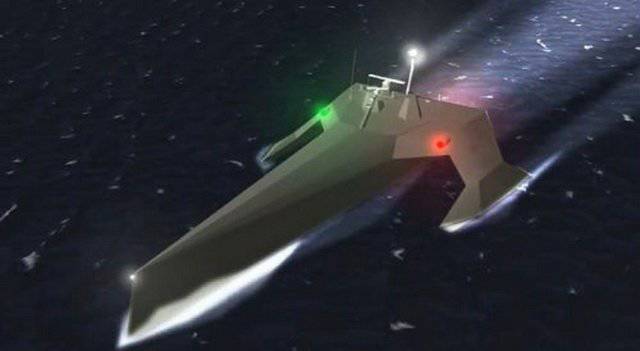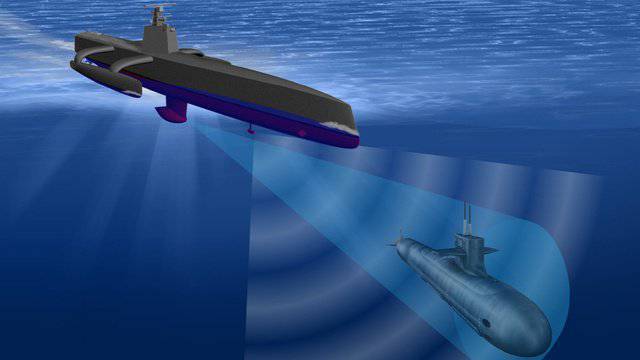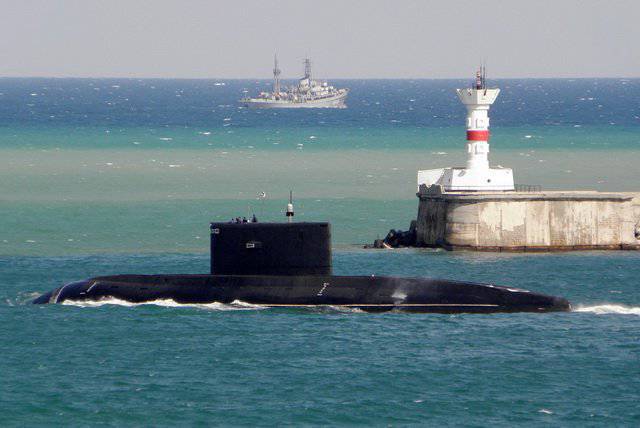ACTUV - Unmanned Robot Hunting Submarine Detection

ACTUV is a modern American project of an unmanned system designed to detect and track enemy submarines. The development of this vessel is under the order of the defense scientific agency DARPA. ACTUV (Anti-submarine warfare Continuous Trail Unmanned Vessel) will use active echolocation to detect enemy submarines. It is assumed that court data will not receive any weapons and will only solve intelligence tasks, but this concept may undergo changes in the future.
The ACTUV creation program includes 4 stages. In August 2012, the completion of the 1st stage of the program was announced (at this stage, the feasibility of its implementation was determined, and other evaluation activities were carried out). The preliminary work schedule for the 2nd and 3rd stages is about 36 months, another 4 months are allotted for the 18th final stage. Accordingly, we are talking about the stages of development, construction and demonstration tests of an experimental sample. Robot-boats.
At present, some characteristics of the ACTUV apparatus, which are design ones, are already known:
- cruising range over 6 000 km;
- the ability to operate at a distance of 3 000 km from the base;
- the battery life of the order of 80 days;
- to detect enemy submarines, it is planned to use the active station GAR;
- the cost of one robot boat will be at the level of 20 million dollars;
- The service life of the order 15 years.

New details and details about the project ACTUV became available thanks to the video, which was published by Science Applications International Corporation (SAIC). The new project of the Pentagon is aimed at the development of robotic ships, which would be able to detect and monitor enemy submarines in a fully automatic mode without human intervention. The main reason for the development of this program was the threat that comes from the growth in the number of relatively inexpensive diesel-electric submarines, which can afford not only the governments of many developing countries, but also more or less large drug cartels.
Submariners have a saying that there are only 2 type ships: these are submarines and targets. These words are quite close to the truth, since modern submarines are one of the most destructive and secretive combat units in the entire vast arsenal of means created by mankind for waging wars. It seems that the Pentagon is seriously expecting to end the era of submarine rule in the ocean, calling for this purpose the robot hunter ACTUV. The defense department has already allocated about 58 million dollars for this project with a high priority.
It is assumed that this robot hunter in a fully autonomous mode will be able to search for enemy submarines for 60-90 days. This ship is planned to be fully integrated into the control system of the US Navy. In particular, it should aim anti-submarine target Aviation, and also to work with sonar buoys that were dropped from helicopters and aircraft. The main working tool for ACTUV should be sonar.

In case of detection of an enemy submarine, the robot hunter approaches it and transmits data about its location to the nearest warship. In this case, the unmanned ship may follow the submarine until it leaves the area of its patrol or until it is destroyed. It is worth noting that the robot hunter doesn’t even have to hide at the same time, he may be engaged in scanning the ocean in the open, using a more effective radiating mode of his sonar. Of course, an enemy submarine will be able to destroy the robot, but at the same time it will surely find itself, without solving its main combat mission, for submarines armed with strategic nuclear missiles - this is unacceptable.
Separately, it should be noted that, unlike a large number of unmanned vehicles that are in the service of the military, the ship-hunter ACTUV does not have any weapons. The main task of the ship is to search, track and escort enemy submarines. In case of necessity of carrying out active actions, other ships and aircraft of the US Navy will have to enter the business. The hunter ship can operate completely independently, it will only be necessary for the person to control it when the ship leaves the ocean from a fairly busy port harbor.
Navigation of the ship in the autonomous mode is realized through a combination of the system of various onboard sensors and artificial intelligence. It is assumed that among these sensors will be long-range and short-range radar, electro-optical sensors, laser scanner LIDAR (Light Detection And Ranging) and other equipment. At that moment, when ACTUV will be close to the intended location of the enemy submarine, it will use a pair of high-frequency sonars that have an active “backlight” system, which allows increasing its range and accuracy of operation. Additional information about the submarine will have to be given by especially sensitive sensors-magnetometers. Based on all the collected data, the unmanned hunter ship will be able to build an image of a submarine and determine its type, identify the submarine and determine its belonging to a particular country.
All collected data will be processed by the system on the basis of artificial intelligence (it is assumed that it will be able to calculate even the nearest intentions of the enemy ship on a number of data obtained). So, for example, one of the fairly common tactics of evading submarines from detection is hiding under an ordinary ship that goes on the sea surface. Knowing about such a maneuver of evasion, the robotic ship-hunter will be able to independently pay more attention to those ships that move in a controlled direction in a given water area. Naturally, the artificial intelligence system will not be so perfect. An experienced submariner, in any case, with the help of his tricks will be able to leave the hunter ship in the cold, but in this case ACTUV can come under the control of a human operator who can independently correct possible system errors and direct the ship on the right search path.
The appearance of the first prototypes of the ACTUV spacecraft, which will undergo a program of fairly extensive sea tests, is possible only in a few years. But in the event that DRAPA is able to carry out these works successfully and bring them to a logical end, the new ACTUV hunter ships can be the factor that will change the rules of the game and counteract the submarines on the high seas.
Information sources:
-http: //www.arms-expo.ru/049057052048124051048050049053.html
-http: //www.dailytechinfo.org/military/4394-opublikovany-podrobnosti-proekta-sozdaniya-sudov-robotov-ohotnikov-za-podvodnymi-lodkami.html
-http: //blog.kp.ru/users/4052155/post256725165/
Information